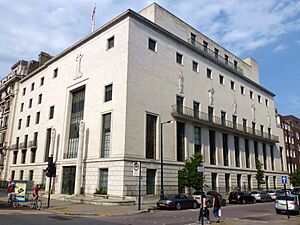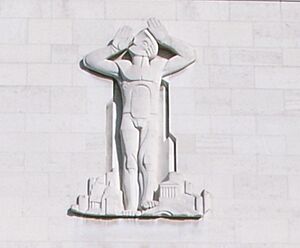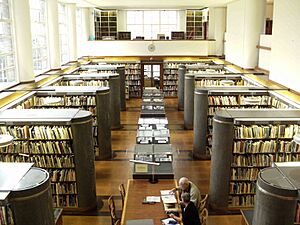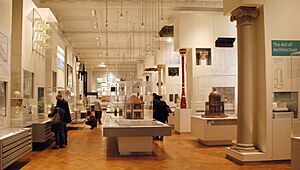Royal Institute of British Architects facts for kids
 |
|
| Abbreviation | RIBA |
|---|---|
| Formation | 1834 |
| Type | Professional membership body |
| Legal status | Chartered body corporate and registered charity |
| Purpose | The objectives of the RIBA, as set out in its Charter, are advancement of architecture and promotion of acquiring of knowledge of the arts and sciences connected therewith. |
| Headquarters | 66 Portland Place, London, W1 |
|
Region served
|
Predominantly UK with increasing global membership |
|
Membership
|
29,203 chartered architects (2020) |
|
Chief Executive
|
Valerie Vaughan-Dick |
|
President
|
Muyiwa Oki |
|
Main organ
|
RIBA Board & RIBA Council |
|
Staff
|
309 (2019) |
The Royal Institute of British Architects (RIBA) is a group for architects. It mainly helps architects in the United Kingdom, but also around the world. RIBA was started in 1834 to help architecture grow and improve.
RIBA has its main office in London at 66 Portland Place. It also has many smaller offices in other areas. The RIBA Library, also started in 1834, is one of the biggest architecture libraries in the world. It is the largest in Europe. RIBA has also helped set up rules for architects in the UK.
The institute gives out some of the oldest awards for architecture. These include the RIBA President's Medals Students Award, the Royal Gold Medal, and the Stirling Prize. RIBA also runs contests for new building designs.
For a long time, RIBA was mostly for men. Women were first allowed to join in 1898. The first female president was chosen in 2009.
Contents
- What is RIBA?
- RIBA's Story: A Look Back
- Learning About Architecture
- How RIBA is Organized
- RIBA's Main Building
- RIBA Awards: Celebrating Great Architecture
- RIBA Competitions: Designing the Future
- The RIBA Plan of Work
- Becoming an Architect
- RIBA Presidents
- RIBA Chief Executives
- Images for kids
- See also
What is RIBA?
The Royal Institute of British Architects, or RIBA, is a professional group. It supports architects and helps them learn and grow. RIBA works to make architecture better for everyone.
RIBA's Main Goals
RIBA's main goals are set out in its Royal Charter. This is a special document that gives RIBA its powers. The goals are:
- To make architecture better.
- To help people learn about the arts and sciences related to building.
RIBA helps architects by providing training and setting standards. It also offers resources like its huge library.
RIBA's Story: A Look Back
RIBA started in London in 1834. It was first called the "Institute of British Architects in London." Many famous architects helped create it. Thomas de Grey, 2nd Earl de Grey was its first president for 25 years.
Becoming "Royal"
In 1837, King William IV gave the institute a special "Royal Charter." This made it the "Royal Institute of British Architects in London." In 1892, it dropped "in London" from its name.
In 1934, RIBA moved to its current home at 66 Portland Place. King George V and Queen Mary opened the new building.
The RIBA Motto
RIBA has a special medal and a Latin motto. The motto is Usui civium, decori urbium. This means "for the use of the people, for the glory of the city." It shows that architecture should serve people and make cities beautiful.
Learning About Architecture
RIBA and its members have played a big part in how architects learn in the UK. They helped create groups like the Architects' Registration Council of the United Kingdom (ARCUK). This group makes sure architects are properly trained and registered.
RIBA still checks architecture courses today. They make sure schools teach students what they need to know. This helps students become good architects. RIBA also checks courses outside the UK.
In 2019, RIBA started the "RIBA Future Architects" program. This is an online place and network for students and new graduates. It helps them as they move from studying to working as architects.
How RIBA is Organized
RIBA is run by the RIBA Council. This group has 60 members. Most of them are experienced architects. They are chosen by other RIBA members.
RIBA has about 44,000 members. Architects who are "chartered members" can use "RIBA" after their name. This shows they are officially recognized.
Different Types of Members
- RIBA: A chartered member. This is the main type of membership.
- FRIBA: A Fellow of the Royal Institute of British Architects. This was a special title given in the past.
- PRIBA: The President of the institute.
RIBA's Offices Around the UK and World
RIBA has 12 offices in different parts of the United Kingdom. Each office works with local architect groups.
- RIBA East – Great Shelford
- RIBA East Midlands – Nottingham
- RIBA London – London
- RIBA North East – Newcastle
- RIBA North West – Liverpool
- RIBA South / South East – Reading
- RIBA South West / Wessex – Bristol
- RIBA West Midlands – Birmingham
- RIBA Yorkshire – Leeds
- RIAS – Royal Incorporation of Architects in Scotland, Edinburgh
- RSAW – Royal Society of Architects in Wales, Cardiff
- RSUA – Royal Society of Ulster Architects, Belfast
RIBA also has international offices. These are in London, Shanghai, and Sharjah (United Arab Emirates). There are four main groups for members outside the UK:
- RIBA Americas
- RIBA Asia and Australasia
- RIBA Europe
- RIBA Middle East and Africa
RIBA's Main Building
RIBA's main building is at 66 Portland Place in London. It has been there since 1934. This building is very special and is protected as a Grade II* listed building. It was designed by architect George Grey Wornum. You can see sculptures by Edward Bainbridge Copnall and James Woodford on it.
The building is open to the public. Inside, you can find a library, a bookshop, a café, and places for exhibitions and talks. RIBA also rents out rooms for events.
In 2021, RIBA decided to sell another building it owned nearby. This was because more staff were working from home after the COVID-19 pandemic. RIBA is now planning a big update for its 66 Portland Place building.
The British Architectural Library
The British Architectural Library, also called the RIBA Library, started in 1834. Members gave books and items to begin the collection. Now, it has over four million items. It is one of the biggest architectural libraries in the world.
Some items from the library are shown at the Victoria and Albert Museum (V&A) in London. The library's collections include:
- Archives: Personal papers, letters, and notes from architects.
- Audiovisual materials: Recordings of talks given at RIBA.
- Books: 150,000 books, with the oldest from 1478.
- Drawings: 1 million drawings, mostly by British architects. It has the world's largest collection of drawings by Andrea Palladio.
- Models: Small models of buildings by architects like Denys Lasdun.
- Periodicals: 2,000 different architecture magazines and journals.
- Photographs: 1.5 million photos, including old pictures from the 19th century.
The library stayed open even during World War II. It even kept safe the papers of architect Adolf Loos during the war.
The library has two public locations. One is the Reading Room at 66 Portland Place. The other is at the V&A Museum. The Reading Room has its original 1934 design. The library is free to visit. It also offers programs for students and families.
RIBA and the V&A Museum
Since 2004, RIBA and the V&A have worked together. They want to help people understand and enjoy architecture more.
They created the Architecture Gallery at the V&A. This was the first permanent gallery in the UK just for architecture. It shows items from both RIBA and V&A collections.
In 2022, RIBA announced that this partnership will end in 2027. The items will go back to RIBA's collections. Some will be shown at the updated 66 Portland Place building.
RIBA Awards: Celebrating Great Architecture
RIBA gives out many awards to celebrate great architecture.
The President's Medals started in 1836. They are the oldest awards from RIBA. They might even be the oldest architecture awards in the world.
Other important awards include:
- The Stirling Prize: For the best new building of the year.
- The Royal Gold Medal: Honors an architect's whole career. It started in 1848.
- The Stephen Lawrence Prize: For smaller building projects.
- The RIBA House of the Year award: For the best house design.
RIBA also gives out regional awards in different parts of the UK.
RIBA Competitions: Designing the Future
RIBA Competitions is a special part of RIBA. It organizes contests for architectural and other design projects.
When someone wants a new building, they might hold a design competition. Architects submit their ideas. A group of experts then chooses the best design. This helps make sure the best ideas are used for new buildings.
The RIBA Plan of Work
The RIBA Plan of Work is a guide for building projects. It helps manage the design and building process step-by-step. It was first created in 1963.
The newest version is the RIBA Plan of Work 2020. It has eight stages, from 0 to 7. This plan is very important in the UK building industry.
Becoming an Architect
RIBA helps schools teach architecture. It checks and approves courses at over 50 schools in the UK. It also approves courses in other countries.
To become a chartered architect, it takes at least seven years.
- Part I: Usually a three-year university degree.
- Year Out: At least one year of work experience in an architect's office.
- Part II: Usually a two-year postgraduate diploma or master's degree.
- Another Year Out: Another year of work experience.
- RIBA Part III: Professional exams.
After passing these, a student can become a chartered architect.
RIBA Presidents
RIBA Presidents are chosen by RIBA members. They serve for two years and lead the RIBA Council. The first president was chosen in 1835. In 2009, Ruth Reed became the first female president.
The current RIBA president is Muyiwa Oki. He started his term in September 2023.
- 1835–1859 Thomas Philip Earl de Grey
- 1860–1861 Charles Robert Cockerell
- 1861–1863 William Tite
- 1863–1865 Thomas Leverton Donaldson
- 1865–1867 Alexander James Beresford-Hope
- 1867–1870 William Tite
- 1870–1873 Thomas Henry Wyatt
- 1873–1876 George Gilbert Scott
- 1876–1879 Charles Barry, Jr.
- 1879–1881 John Whichcord Jr.
- 1881–1881 George Edmund Street
- 1882–1884 Horace Jones
- 1884–1886 Ewan Christian
- 1886–1887 Edward I'Anson
- 1888–1890 Alfred Waterhouse
- 1891–1894 John Macvicar Anderson
- 1894–1896 Francis Penrose
- 1896–1899 George Aitchison
- 1899–1902 William Emerson
- 1902–1904 Aston Webb
- 1904–1906 John Belcher
- 1906–1908 Thomas Edward Collcutt
- 1908–1910 Ernest George
- 1910–1912 Leonard Stokes
- 1912–1914 Reginald Blomfield
- 1914–1917 Ernest Newton
- 1917–1919 Henry Thomas Hare
- 1919–1921 John William Simpson
- 1922–1923 Paul Waterhouse
- 1923–1925 John Alfred Gotch
- 1925–1927 Edward Guy Dawber
- 1927–1929 Walter Tapper
- 1929–1931 Banister Flight Fletcher
- 1931–1933 Raymond Unwin
- 1933–1935 Giles Gilbert Scott
- 1935–1937 Percy Thomas
- 1937–1939 Harry Stuart Goodhart-Rendel
- 1939–1940 Edwin Stanley Hall
- 1940–1943 William Henry Ansell
- 1943–1946 Sir Percy Thomas
- 1946–1948 Lancelot Keay
- 1948–1950 Michael Waterhouse
- 1950–1952 Andrew Graham Henderson
- 1952–1954 Howard Robertson
- 1954–1956 Charles Herbert Aslin
- 1956–1958 Kenneth Cross
- 1958–1960 Basil Spence
- 1960–1962 William Holford
- 1962–1964 Robert Hogg Matthew
- 1964–1965 Donald Evelyn Edward Gibson
- 1965–1967 Lionel Gordon Baliol Brett
- 1967–1969 Hugh Wilson
- 1969–1971 Peter Faulkner Shepheard
- 1971–1973 Alex Gordon
- 1973–1975 Fred Pooley
- 1975–1977 Eric Lyons
- 1977–1979 Gordon Graham
- 1979–1981 John Brian Jefferson
- 1981–1983 Owen Luder
- 1983–1985 Michael Manser
- 1985–1987 Larry Rolland
- 1987–1989 Rod Hackney
- 1989–1991 Maxwell Hutchinson
- 1991–1993 Richard MacCormac
- 1993–1995 Frank Duffy
- 1995–1997 Owen Luder
- 1997–1999 David Rock
- 1999–2001 Marco Goldschmied
- 2001–2003 Paul Hyett
- 2003–2005 George Ferguson
- 2005–2007 Jack Pringle
- 2007–2009 Sunand Prasad
- 2009–2011 Ruth Reed
- 2011–2013 Angela Brady
- 2013–2015 Stephen Hodder
- 2015–2017 Jane Duncan
- 2017–2019 Ben Derbyshire
- 2019–2021 Alan Jones
- 2021–2023 Simon Allford
- 2023–2025 Muyiwa Oki
RIBA Chief Executives
The person in charge of RIBA's daily operations used to be called the "secretary." Now, this role is called the "chief executive."
- 1871–1878 Charles Eastlake
- 1878–1896 William H. White
- 1897–1907 William John Locke
- 1908–1943 Sir Ian MacAlister
- 1945–1959 Cyril Douglas Spragg
- 1959–1968 Gordon Randolph Ricketts
- 1968–1987 Patrick Harrison
- 1987–1994 Bill Rodgers
- 1994–2000 Alexander Reid
- 2000–2009 Richard Hastilow
- 2009–2016 Harry Rich
- 2016–2022 Alan Vallance
- 2023–present Valerie Vaughan-Dick
Images for kids
See also
 In Spanish: Royal Institute of British Architects para niños
In Spanish: Royal Institute of British Architects para niños
- Royal Town Planning Institute
- Chartered Institute of Architectural Technologists
- Chartered Institute of Building
- Construction Industry Council
- Joint Contracts Tribunal
- RIBA Knowledge Communities
- The Georgian Group






